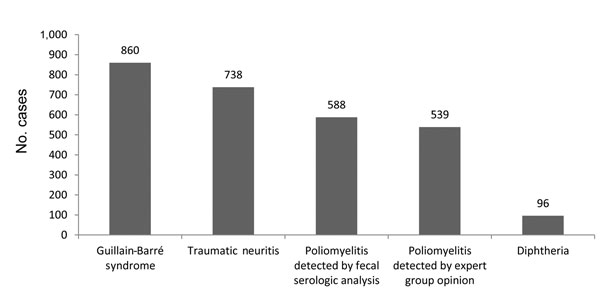Volume 19, Number 9—September 2013
Synopsis
Detection of Diphtheritic Polyneuropathy by Acute Flaccid Paralysis Surveillance, India
Figure

Figure. . Reported cases of acute flaccid paralysis in children <15 years of age in India caused by selected factors affecting the peripheral nerve and anterior horn cell, taken from discarded cases in which fecal samples were inadequate to confirm or refute poliomyelitis on the basis of timing of samples or other reasons, 2008. Cases indicated as diphtheria were deemed diphtheritic polyneuropathy by the Expert Review Committee and were suggestive of diphtheritic polyneuropathy but may not meet standard case definitions such as those derived in the European Union. Values above bars are numbers of cases.
1Current affiliation: Massachusetts General Hospital, Boston, Massachusetts, USA.
Page created: August 20, 2013
Page updated: August 20, 2013
Page reviewed: August 20, 2013
The conclusions, findings, and opinions expressed by authors contributing to this journal do not necessarily reflect the official position of the U.S. Department of Health and Human Services, the Public Health Service, the Centers for Disease Control and Prevention, or the authors' affiliated institutions. Use of trade names is for identification only and does not imply endorsement by any of the groups named above.